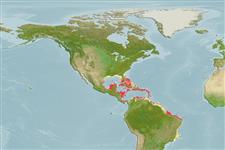>
Eupercaria/misc (Various families in series Eupercaria) >
Scaridae (Parrotfishes) > Scarinae
Etymology: Scarus: Greek, skaros = a fish described by anciente writers as a parrot fish; 1601 (Ref. 45335).
Environment: milieu / climate zone / depth range / distribution range
Écologie
marin récifal; profondeur 2 - 25 m (Ref. 9710). Tropical; 33°N - 34°S, 98°W - 31°W
Western Atlantic: Bermuda, southern Florida (USA), and Bahamas to Brazil; throughout the Caribbean (Ref. 3802).
Length at first maturity / Taille / Poids / Âge
Maturity: Lm ?, range 17 - ? cm
Max length : 35.0 cm TL mâle / non sexé; (Ref. 9710); common length : 22.0 cm TL mâle / non sexé; (Ref. 3802)
Épines dorsales (Total): 9; Rayons mous dorsaux (Total): 10; Épines anales 3; Rayons mous anaux: 9. Juveniles and young adults dark olive above with 2 broad dark stripes: upper from tip of snout through eye to middle of caudal fin base, lower from chin through pectoral fin base to lower caudal fin base; white area above upper stripe continues around front of head above eye (Ref. 26938).
Found on bottoms with coral or rock (Ref. 13628). Juveniles often occur in association with Thalassia. Forms large feeding aggregations and feeds on plants. Sleeps in a mucus cocoon (Ref. 9710).
Life cycle and mating behavior
Maturité | Reproduction | Frai | Œufs | Fécondité | Larves
Oviparous, distinct pairing during breeding (Ref. 205).
Robins, C.R. and G.C. Ray, 1986. A field guide to Atlantic coast fishes of North America. Houghton Mifflin Company, Boston, U.S.A. 354 p. (Ref. 7251)
Statut dans la liste rouge de l'IUCN (Ref. 130435)
Menace pour l'homme
Reports of ciguatera poisoning (Ref. 30303)
Utilisations par l'homme
Pêcheries: intérêt commercial mineur; Aquarium: Commercial
Plus d'informations
RéférencesAquacultureProfil d'aquacultureSouchesGénétiqueElectrophoresesHéritabilitéPathologiesTraitementNutrientsMass conversion
Outils
Articles particuliers
Télécharger en XML
Sources Internet
Estimates based on models
Preferred temperature (Ref.
123201): 26.2 - 28.2, mean 27.4 °C (based on 664 cells).
Phylogenetic diversity index (Ref.
82804): PD
50 = 0.5000 [Uniqueness, from 0.5 = low to 2.0 = high].
Bayesian length-weight: a=0.01445 (0.00686 - 0.03044), b=3.03 (2.86 - 3.20), in cm total length, based on LWR estimates for this Genus-body shape (Ref.
93245).
Niveau trophique (Ref.
69278): 2.0 ±0.1 se; based on diet studies.
Résilience (Ref.
120179): Haut, temps minimum de doublement de population inférieur à 15 mois (Preliminary K or Fecundity.).
Fishing Vulnerability (Ref.
59153): Low vulnerability (25 of 100).
Nutrients (Ref.
124155): Calcium = 44.1 [28.9, 73.8] mg/100g; Iron = 0.791 [0.556, 1.203] mg/100g; Protein = 18.6 [16.5, 20.4] %; Omega3 = 0.0898 [, ] g/100g; Selenium = 18.1 [11.3, 28.4] μg/100g; VitaminA = 51 [16, 166] μg/100g; Zinc = 2.33 [1.77, 3.01] mg/100g (wet weight);
